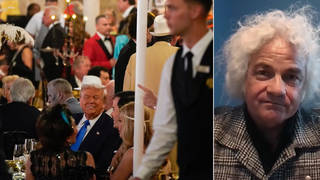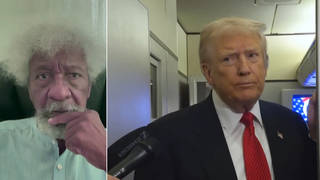
President Bush spoke on national tv night and called for 6,000 National Guard troops to be deployed to the U.S.-Mexican border. We looking at the growing militarization of the border and the role private contractors, like Halliburton, are playing. [includes rush transcript]
President Bush made a rare prime-time address Monday night to outline his administration’s plan for one of the country’s most contentious and impassioned political issues — immigration and border control. It was the President’s most detailed statement on the subject since a recent surge of record-breaking demonstrations brought the plight of the country’s estimated 12 million undocumented workers to increased national and international attention.
In his speech, the President outlined what he called a “middle ground approach.” Bush reiterated his call for a temporary guest worker program he promised would put undocumented workers on a path to citizenship if they agreed to meet certain requirements, including the payment of fines. But the President also outlined a series of enforcement measures including the deployment of 6,000 National Guard members to the border and the expansion of detention centers for those caught entering the country illegally. The President also called for the creation of an identification card system that would collect digitized fingerprints of undocumented workers.
- President Bush, speaking on May 15, 2006 from the White House.
Bush insisted his government is not going to militarize the southern border with Mexico. But critics say the President’s measures, including deployment of the National Guard, are just the latest in a militarization process that began years before Bush even took office.
- Fernando Garcia, Director of the Border Network for Human Rights in El Paso, Texas.
- Timothy Dunn, Professor of Sociology at Salisbury University in Maryland. He is Author of “The Militarization of the U.S.-Mexico Border: Low Intensity Conflict Doctrine Comes Home.”
- Joseph Nevins, a Professor of Geography at Vassar College. He is author of a number of books including “Operation Gatekeeper: The Rise of the Illegal Alien and the Making of the U.S.-Mexico Boundary”. He is currently working on a book about migrant deaths along the U.S.-Mexico boundary. He joins us on the line from Omaha, Nebraska.
- Joe Richey, investigative journalist who’s covered Homeland Security’s Border Protection programs for Alternet and FreeSpeech TV.
Transcript
AMY GOODMAN: President Bush had a rare prime-time address last night to outline his administration’s plan for one of the country’s most contentious and impassioned political issues: immigration and border control. It was the President’s most detailed statement on the subject since a recent surge of record-breaking demonstrations brought the plight of the country’s estimated 12 million undocumented immigrants to increased national and international attention.
In his address, the President outlined what he called a “middle ground approach.” Bush reiterated his call for a temporary guest worker program he promised that he would put undocumented workers on a path to citizenship if they agreed to meet certain requirements, including the payment of fines. But the President also outlined a series of enforcement measures, including the deployment of 6,000 National Guard members to the border and the expansion of detention centers for those caught entering the country illegally. The President also called for the creation of an identification card system that would collect digitized fingerprints of undocumented workers.
PRESIDENT GEORGE W. BUSH: We do not yet have full control of the border, and I am determined to change that. Tonight I’m calling on Congress to provide funding for dramatic improvements in manpower and technology at the border. By the end of 2008, we’ll increase the number of Border Patrol officers by an additional 6,000. When these new agents are deployed, we’ll have more than doubled the size of the Border Patrol during my presidency.
At the same time, we’re launching the most technologically advanced border security initiative in American history. We will construct high-tech fences in urban corridors and build new patrol roads and barriers in rural areas. We’ll employ motion sensors, infrared cameras, and unmanned aerial vehicles to prevent illegal crossings. America has the best technology in the world, and we will ensure that the Border Patrol has the technology they need to do their job and secure our border.
Training thousands of new Border Patrol agents and bringing the most advanced technology to the border will take time. Yet the need to secure our border is urgent. So I’m announcing several immediate steps to strengthen border enforcement during this period of transition.
One way to help during this transition is to use the National Guard. So, in coordination with governors, up to 6,000 Guard members will be deployed to our southern border. The Border Patrol will remain in the lead. The Guard will assist the Border Patrol by operating surveillance systems, analyzing intelligence, installing fences and vehicle barriers, building patrol roads and providing training. Guard units will not be involved in direct law enforcement activities; that duty will be done by the Border Patrol. This initial commitment of Guard members would last for a period of one year. After that, the number of Guard forces will be reduced as new Border Patrol agents and new technologies come online. It is important for Americans to know that we have enough Guard forces to win the war on terror, to respond to natural disasters and to help secure our border.
The United States is not going to militarize the southern border. Mexico is our neighbor and our friend. We will continue to work cooperatively to improve security on both sides of the border, to confront common problems like drug trafficking and crime and to reduce illegal immigration.
AMY GOODMAN: President Bush speaking Monday night from the Oval Office. Bush insisted his government is not going to militarize the southern border with Mexico, but critics say the President’s measures, including deployment of the National Guard, are just the latest in a militarization process that began years before Bush even took office. To talk about this, we go first to Las Cruces, New Mexico, where we’re joined by Fernando Garcia. He’s the Director of the Border Network for Human Rights. We welcome you to Democracy Now!, Fernando.
FERNANDO GARCIA: Good morning, Amy.
AMY GOODMAN: It’s good to have you with us. Your response to President Bush?
FERNANDO GARCIA: Let me start with a testimony. On May 20, 1997, a U.S. Marine shot and killed an 18-year-old goat herder, Ezekiel Hernandez, in the village of Redford, Texas. Ezekiel was a U.S. citizen, was a border resident. He was killed by Marines that were wearing full camouflage under the Border Patrol’s supervision. No Marines were charged ever of this killing.
I think we’re extremely frustrated and disappointed with the President’s announcement, because we feel that he fell into the temptation of militarizing the border by sending these troops. And it is not practical. It doesn’t have any sense, it’s not logic. And the only way that you can understand this, that we can understand this is this is more a political move, where the President is willing to sacrifice our border communities, our border residents that are entitled to rights and constitutional protections. So we believe that that is sending a very wrong message to our border communities, because the border is not a fence. The border is not just a river. It’s about families, U.S. citizens, residents. And what they are talking about is sending these troops into our communities.
AMY GOODMAN: What do you think has to be done?
FERNANDO GARCIA: We believe that the right approach is to have comprehensive immigration reform. I think there are two positive things in what the President mentioned. One is to legalize; they recognize that we need to legalize the 12 million people that is living here undocumented. I think that is an important step. The second one that the President also mentioned is that we need to create some kind of program to bring people legally into the country, so we would need at least 500,000 visas every year to bring workers, so they won’t cross the river, they won’t cross through the desert. So, we need to have something more comprehensive, because this is not an enforcement issue. This is more an economic issue, and at the end it’s a human rights issue.
AMY GOODMAN: We’re also joined on the telephone by Timothy Dunn, Professor of Sociology at Salisbury University in Maryland, author of The Militarization of the U.S.-Mexico Border: Low Intensity Conflict Doctrine Comes Home. Professor Dunn, you wrote a piece called “A Perfect Storm on the U.S.-Mexican Border as Drug and Immigration and Terror Wars Converge.” Explain, and also respond to President Bush’s proposal that he outlined last night.
TIMOTHY DUNN: Well, all these different rationales are coming together as a pretext to use greater enforcement resources at the border for what are largely, as Fernando said, not enforcement issues, but in the case of immigration, certainly economic issues and social issues. And the use of the military is only the most extreme step in this. We’ve never seen this scale of the use of military before, although they have been involved for 16, 17 years in some form or another. And also the Border Patrol have acted more like the military, received military training and so on, so the police acting like the military and the military getting involved in police matters, working together. And that’s relatively rare in American history. But it’s common in other settings where there are widespread human rights problems.
And the shooting of Ezekiel Hernandez, that Fernando mentioned, in 1997 is only the most extreme, but unfortunately logical outcome of the escalation of this process. And after that, the military really limited the use of armed ground troops.
What the President did not make clear last night is what are they going with these 8,000 or 6,000 troops down there? He said they’re not going to have direct enforcement rules, but there just aren’t that many support jobs for them to do. And it depends on what they say they’re going to do. They have said in the reports today that they will be armed and be able to protect themselves. So, they should never even be put in a position where they need to do that, because if they are, the chance for mistakes among border residents, among border crossers and others goes up greatly.
And these people are not a physical threat for the country. New reports out last week found that what we all know is that no terrorist has ever been caught crossing the Southwest border. Several have been caught crossing the Canadian border. There’s no significant terrorist threat whatsoever in Mexico. There are some allegedly in Canada among the Muslim immigrant population there. So why are we looking at Mexico as the problem here. It’s just been totally a backward way of looking at things.
And as Walter Ewing at the American Immigration Law Foundation put it in a recent paper, if you want to look for a needle and haystack, if you’re looking at all these suspected transnational threats among all these labor migrants, then you need to reduce the size of the haystack. And how you do that is the measures that Fernando mentioned. You have to have comprehensive immigration reform that will reduce the flow of people who feel compelled to come illegally, because the immigration policy is just completely dysfunctional at the moment.
AMY GOODMAN: Professor Timothy Dunn is at Salisbury University in Maryland. We’re also joined on the phone by Joseph Nevins, who’s a professor of Geography at Vassar College, author of a number of books, including Operation Gatekeeper: The Rise of the Illegal Alien and the Making of the U.S.-Mexico Boundary. He’s currently working on a book about migrant deaths along the U.S.-Mexico border. You’re joining us from Omaha, Nebraska, right now. Do you think this will lead to increased deaths, Professor Nevins?
JOSEPH NEVINS: Absolutely. Good morning, Amy. We have seen over the last ten years a rapid increase in the number of migrant deaths. While deaths have long been associated with unauthorized crossings of the U.S.-Mexico boundary, going all the way back to the late 1800s when Chinese were first beginning to try to circumvent the Chinese Exclusion laws, we’ve seen a dramatic increase over the last ten years that is the predictable response or outcome to a rapid intensification of militarization that began under the Clinton administration around 1994 and 1995.
It’s conservatively estimated that well over 3,600 migrants have died trying to cross the U.S.-Mexico boundary over the last ten years. I say it’s conservative, because that estimate is only based on bodies that have actually been found. Given the huge expanse of the U.S.-Mexico border region and the very difficult climatic conditions, many bodies are never found, and many of them break down very quickly. So it’s thought by people that live and focus on migrant deaths in the border region that many thousands more over that 3,600 have actually died in the last ten years.
AMY GOODMAN: I want to go back to the Las Cruces, New Mexico studio to speak with Fernando Garcia. Right now, what is the feeling of people along the border? So often you’ll get the response that it’s the communities themselves, in fact, immigrant communities that are opposed to undocumented immigration?
FERNANDO GARCIA: I think we have a feeling, living at the border, we can feel — I mean, we live in this extreme fear of living in this violent border. And I want to clarify that at the border region, there are many U.S. residents, U.S. citizens actually, that actually are afraid of these policies. We have a massive presence of the Border Patrol in our streets. We have 44 agencies combined in our communities, and on top of that, we’re going to have 6,000 troops. So, this doesn’t make any sense for our communities.
We believe that national security should also consider community security, and what the President is not necessarily considering in his speech last night is that any kind of protections for border communities, there’s no accountability processes, there’s no oversight, there is no protection for civil or constitutional rights. And the worst of it is that all of these policies are being done without any consultation with our border communities, with our elected officials, with our local sheriffs, with the different sectors living in these border communities. And I think this is just going to increase the fear and the violence in our border communities.
AMY GOODMAN: I wanted to ask Professor Nevins about the Democratic response. President Bush now has proposed sending 6,000 National Guard to the border. We know what Congressman Sensenbrenner has put forward, the House bill that criminalizes the undocumented immigrant population, not to mention those that would help them, like priests, nuns, social worker, doctors. But what about the Democratic response?
JOSEPH NEVINS: Senator Richard Durbin, Democrat of Illinois, was in charge of the official Democratic response last night, and what he did was rhetorically, he criticized Bush and the Republicans in militarizing the border and criminalizing immigrants. But at the same time, he made very clear that substantively there’s really no difference between the mainstream Democrats and what the Bush administration is advocating. In this regard, the Democrats’ position on immigration and poverty enforcement is very similar to the Democratic establishment position on Iraq.
The war itself, the war on immigrants, the war on the border isn’t in and of itself the problem. The problem is one of management. The Democrats say they can wage the war better and more effectively. So, it’s not a question of withdrawal, it’s not a question of re-examining the basic assumptions underlying war; it’s to wage it again more effectively. So, despite saying that, you know, the Democrats didn’t like the criminalization and militarization, Durbin said that they have no problem using the National Guard on the border. They also said that what they want to see is a more rapid increased number of Border Patrol agents.
You asked earlier about deaths. I mean, this is just one form of hardship that has been brought about as a result of the rapid intensification of boundary enforcement. There’s massive deportations. There’s the division of communities and families. There’s an increased climate of fear here in workplaces, etc., etc. And the Democrats are only about intensifying this.
And what’s striking about all of this is just how incredibly the intensification of border militarization has failed to meet its stated objectives of significantly diminishing the number of unauthorized crossings. All of the academic studies, including those done by Douglas Massey at University of Pennsylvania and Wayne Cornelius and others at the University of California at San Diego, say that for the most part there’s been no significant reduction in the number of people that are crossing. What people are doing is relying increasingly on costly smuggling networks; they’re taking more arduous and risky routes. They’re just innovating.
And it’s extremely doubtful that this intensification that’s being advocated by Bush, by extension of the Democrats and the Republicans, are going to result in any sort of diminishing of a number of unauthorized crossings. So my guess is that it will increase the number of deaths and things of that sort, but what it will also lead to in the next ten years is our revisiting the very same sort of issues that we’re talking about today.
AMY GOODMAN: Well, before we move to our next segment, we want to look at the growing role of companies like Halliburton and the privatization of border control and enforcement. And we’re joined on the phone by Joe Richey, who’s an investigative journalist, covered Homeland Security border protection programs for Alternet and Free Speech TV, joining us on the line from Colorado. Joe Richey, what about this issue of President Bush raising increased — the expansion of the detention system and how that fits into privatization?
JOE RICHEY: Well, it’s one piece of the internal enforcement at the Department of Homeland Security. Border protection is yet another frontier, so to speak. And you got to ask the question like a good journalist, Amy: who benefits from this? And when you do, you see there is a whole coterie of companies standing ready, willing, able to provide Homeland Security with new detention beds, more private security along the border. The privatization of Homeland Security is about to undergo a new heave with the Secure Border Initiative and its accompanying privatization plan, SBInet.
The companies that stand to benefit, well, already we’ve seen in detention Corrections Corporation of America, the G.E.O. Group, the former Wackenhut family, and also Kellogg Brown & Root, the Halliburton subsidiary, who was awarded a contract in the event of an immigration emergency. These are contingency — that’s a contingency contract to KBR. It may not come to be, but they’re ready to put up to 20,000 beds within 48 hours, if needed. When they talk about an immigration emergency — that contract, it’s in the event of a natural disaster. This is some of the language you hear from ICE officials in D.H.S. But here in Colorado, we have had eight Republican congressmen demand the President declare an immigration emergency now. Governors from Arizona and New Mexico have asked for the same. What something like that would look like is being played out, and companies are standing by ready to provide this service when needed.
AMY GOODMAN: Well, I want to thank you for being with us, Joe Richey, who is an investigative journalist with Alternet. Also, I want to thank Professor Joe Nevins, professor at Vassar College, books include Operation Gatekeeper; Professor Timothy Dunn of Salisbury University; and also, finally, I want to thank Fernando Garcia, who is the Director of Border Network for Human Rights based in El Paso, Texas. We will certainly continue this discussion.












Media Options